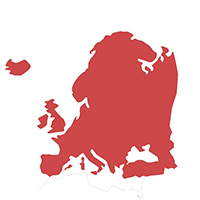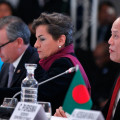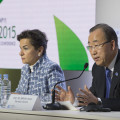Party Time: The Main Players at COP21
Jacqui Fetchet | December 4, 2015.
Almost 200 countries are gathered in Paris to hash out a deal on climate change. The COP21 meeting is one of the biggest gatherings of world leaders in history. Officially it’s the 21st Conference of the Parties to the United Nations Framework Convention on Climate Change or UNFCCC, the global forum for action on climate change. Expect to see ‘announceables,’ hand-shakes and photo-ops.
But behind the suits and smiles lie a patchwork of strategic alliances. The Verb takes a look at the main players.
The European Union
Summary: The EU sees itself as a climate leader and a bit of a hero within the UNFCCC.
Who: Represents the 28 members of the EU.
What: The EU has a legal agenda and will be pushing to get as much in the legally binding agreement as possible, particularly in terms of the review mechanism and accountability. The EU has been a bulwark of carbon trading, though the performance of its emissions trading system suggests its members will have to come up with more innovative and enduring policy responses as carbon markets fall short.
Watch: With France the host nation, the EU will be looking for a strong agreement with all Parties on board to the commitments, moving away from the previous arrangement of tiered levels of involvement. COP21 is an opportunity for the EU to lead, with a key message that emissions trading is inadequate.
The Umbrella Group
Summary: A motley but powerful group of OECD countries, excluding the EU, that bandied together within Annex I in the Kyoto Protocol.
Who: Some of the heavyweights – the US, Canada, Australia, New Zealand, Kazakhstan, Norway, Russia, Japan and Ukraine.
What: Unlike the EU, the US wants as little reference to ‘legally binding’ as possible. For the Obama administration to get an agreement ratified, it would have to pass the US Senate, which is currently not likely. Though capable, this group is mostly conservative and will push to avoid any reference to compensation, locked in figures for climate finance and legally binding intended Nationally Determined Contributions (INDCs).
Watch: These countries suggest have the resources to contribute to climate finance, technology transfer and capacity building for vulnerable countries. The US will look for a strong deal sealed before President Obama’s term ends. Leadership changes in Canada and Australia suggest an opportunity for stronger commitments and support of embedding ambition in the framework.
The G77
Summary: The ‘developing’ countries, or non-Annex I in the Kyoto Protocol. These countries are geographically, economically and politically diverse, and have segmented into smaller alliances within the broader grouping.
Who: Now 134 members, and many of them are no longer classed as ‘developing,’ as in 1992. China, Brazil and India are the big guns. See below for sub-groups of allies.
What: The main sticking point for this group is climate finance. China wants to see a strong agreement that sets the framework for the transition they are already leading at home. India is currently focussed on energy, and will push for low carbon solutions led by developed countries with access to finance for the rest (note that low carbon includes ‘clean coal’, and they will lobby for this language in the text).
Watch: The interesting dynamic will be how sub-groups push to lobby the G77 and China – and may well get left behind, especially vulnerable countries. Climate finance expectations may fall short. South Africa, current chair of the G77, will take a strong leadership stance.
The Least Developed Countries (LDCs)
Summary: The countries most impacted by climate change, both now and in the future, but with the fewest resources for action.
Who: Officially, the LDCs are made up of 48 countries, all within the G77. The African Group of over 50 countries has cross-overs with the LDCs in terms of membership and negotiating objectives.
What: These countries have limited capacity and will be pushing for climate finance commitments. Africa wants an agreement that covers adaptation, anchors loss and damage and enables developing countries with climate finance provisions.
Watch: Alliances with China to push the development agenda and a strong stance by countries currently affected by drought and natural disasters across Africa, Asia and Latin America.
The Association of Small Island States (AOSIS)
Summary: The most vulnerable countries to climate change due to rising oceans, with traditionally strong voices at the UNFCCC from the Maldives, Kiribati and Tuvalu.
Who: 43 low-lying islands and atolls across the Pacific, the Caribbean and the Indian Oceans.
What: The AOSIS message is clear. They are being impacted by climate change now, the very future of their nations is uncertain and climate action can’t wait. They will be pushing to embed a long term goal in the agreement, driven by efforts to limit warming to 1.5°C (as opposed to 2°C) by 2100.
Watch: Some members of AOSIS and the LDCs have gathered to form the Climate Vulnerable Forum and will launch a Declaration for action within the UNFCCC.
The Community of Latin American and Caribbean States (CELAC)
Summary: Latin American countries within the G77.
Who: 33 diverse economies in Latin America and the Caribbean.
What: CELAC delivered a joint regional statement to push for a legally binding agreement and seek strong provisions for finance, capacity building and technology transfer. This is framed on sustainable development and emissions reductions, with most Latin American states submitting INDCs in the lead up to COP21.
Watch: Latin perspectives are diverse. Brazil and Mexico will be vocal, and Peru is motivated to see a strong agreement signed following last year’s COP20 it hosted in its capital Lima. Watch for interesting alliances within Latin American parties and beyond.
***
With all these Parties at the table and a tight timeframe to produce an important agreement, it’s still up in the air what the final text will look like. Find out more about how the treaty progresses with our Negotiation Compass.













comment